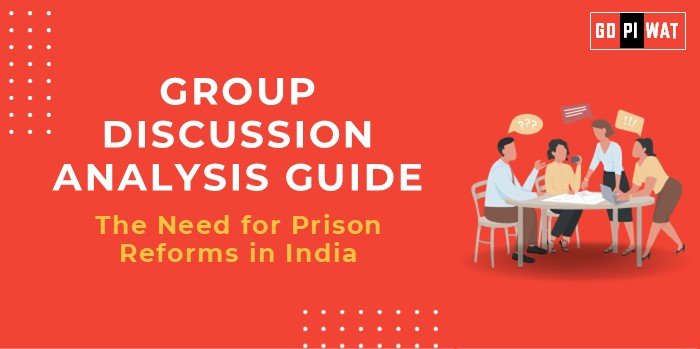📋 Group Discussion (GD) Analysis Guide: The Need for Prison Reforms in India
🌐 Introduction to the Topic
- 📜 Opening Context: “India’s prison system, burdened with over 130% occupancy rates and marred by infrastructural deficiencies, highlights an urgent need for reform in ensuring justice and human rights.”
- 📖 Topic Background: The prison system in India operates under the Prisons Act of 1894, a colonial-era framework that has seen minimal updates. Recent judicial reviews and public debates have emphasized the need to address overcrowding, under-trial detainees, and rehabilitative services.
📊 Quick Facts and Key Statistics
- 📈 Prison Occupancy Rate: 130% as of 2023 (NCRB), highlighting overcrowding.
- ⚖️ Under-trial Prisoners: 76% of the prison population (2023), reflecting judicial delays.
- 🩺 Healthcare Deficiency: 1 doctor per 5,000 prisoners on average, showing inadequate medical care.
- 💰 Budget Allocation: ₹6,500 crores (FY 2023-24), stressing underfunding for reforms.
👥 Stakeholders and Their Roles
- 🏛️ Government Agencies: Ministry of Home Affairs oversees prison administration and allocates reform budgets.
- ⚖️ Judiciary: Supreme Court directives on under-trial reviews and humane treatment.
- 🌐 NGOs & Advocacy Groups: Focus on prison reforms, human rights, and reintegration support.
- 🗣️ Society: Perception shifts and community roles in rehabilitation.
🏆 Achievements and Challenges
✨ Achievements
- 🤝 Open Prisons: Implementation in Rajasthan and Maharashtra, allowing gradual reintegration.
- 📚 Skill Development: Programs initiated in select states for inmates.
- ⚖️ Supreme Court Guidelines: Under-trial reviews led to early release of thousands.
⚠️ Challenges
- 📈 Overcrowding: Occupancy rate surpassing 130%.
- ⏳ Judicial Delays: 76% of inmates are under-trials.
- ❌ Human Rights Violations: Cases of custodial torture and lack of basic amenities.
Global Comparisons:
• Norway: Rehabilitation-centric system with low recidivism rates.
• USA: Similar issues with overcrowding but higher resource allocation.
📢 Structured Arguments for Discussion
- 💬 Supporting Stance: “Prison reforms can reduce recidivism and improve public safety while upholding human rights.”
- 🗣️ Opposing Stance: “Budget constraints and societal stigma pose significant barriers to large-scale reforms.”
- ⚖️ Balanced Perspective: “While reforms are necessary, a phased and resource-backed approach is critical.”
📈 Effective Discussion Approaches
- 💡 Opening Approaches:
- Start with a statistic: “With 76% of prisoners as under-trials, India’s judicial system needs urgent streamlining.”
- Reference a global example: “Norway’s focus on rehabilitation offers valuable lessons for India.”
- 💡 Counter-Argument Handling:
- Acknowledge constraints like budgets but emphasize long-term savings and societal benefits.
- Cite successful pilot projects (e.g., open prisons).
📊 Strategic Analysis of Strengths and Weaknesses
Strengths
- ⚖️ Growing judicial activism.
- 🤝 Potential for public-private partnerships.
Weaknesses
- 📉 Inadequate staffing and funding.
- 🛑 Societal stigma against former inmates.
Opportunities
- 💻 Leverage technology for management and tracking.
- 🌍 Implement proven models from other countries.
Threats
- ⚠️ Resistance to policy changes.
- 📈 Rising crime rates and political hurdles.
🎓 Connecting with B-School Applications
- 💡 Real-World Applications:
- Linking prison reforms to governance, public policy, and management of social justice initiatives.
- 💡 Sample Interview Questions:
- “How can technology aid prison reforms in India?”
- “What role do public-private partnerships play in addressing overcrowding?”
- 💡 Insights for B-School Students:
- Explore CSR initiatives in rehabilitation.
- Study logistics for resource management in underfunded sectors.


